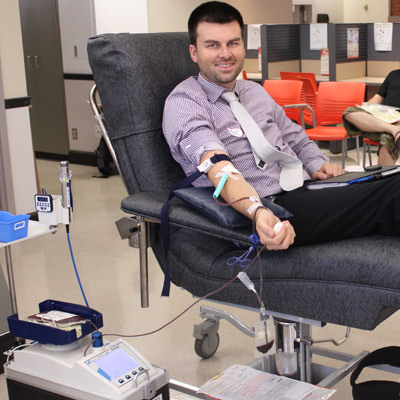 Here I am supporting Team TGH in the Inter-Hospital Blood Drive Challenge (Photo: Dailice Liu, phlebotomist, Canadian Blood Services)
Here I am supporting Team TGH in the Inter-Hospital Blood Drive Challenge (Photo: Dailice Liu, phlebotomist, Canadian Blood Services)
For the first time donor
If you have never donated blood before, maybe it is because you don't know if you are eligible, how long it will take or whether it will be painful. Maybe you've just never thought about it.
Did you know UHN uses 11,000 units of blood (enough to fill a backyard swimming pool) every year? If more UHN staff donated blood, we could have a direct impact on our patients.
I've never donated blood before for many of the above reasons. I decided to go to the Canadian Blood Services (CBS) clinic at College and Elizabeth to find out what the experience is really like.
Arrival and registration
I made my appointment by phone and skipped to the front of the line of walk-ins when I arrived at the clinic. The receptionist registered me as a part of the UHN Inter-Hospital Blood Drive Challenge and booked another appointment for two months later. The minimum amount of time between donations is 56 days.
I received a folder containing a number, questionnaire and a first time donor sticker. I placed the sticker on my shirt and was given special attention from staff because they knew it was my first time. They may have also noticed I was a little jittery as I am not a big fan of needles – who is?
Screening
A staff member checked my haemoglobin (a protein in blood that carries oxygen) by pricking my finger and putting a drop of blood into a machine that measured it in seconds. Low haemoglobin might mean low iron, which your body needs to make new red blood cells. If your haemoglobin is too low you can't donate blood and you may want talk to your doctor to see if you have an iron deficiency.
Next I was sent to a desk to start the questionnaire. The questions, ranging from travel history to dental work, are meant to flag risk factors that could make blood unsafe.
After finishing the first half of the questionnaire Roxanne Osmond, a registered nurse, called me into a small room to finish the second half. The yes/no questions asked mainly about travel, drug use and sexual history. I didn't feel awkward because Osmond was professional, non-judgemental and asked the questions quickly.
When we finished, Osmond left the room in case I was embarrassed to answer the questions honestly in front of her. There is an option to exempt your blood donation with a barcoded sticker. When she came back she checked my pulse, blood pressure and temperature. Apparently I have great blood pressure but terrible veins — they hide under my skin!
I had taken some Tylenol that morning and in the back of my mind hoped Osmond would spare me the needle when she found out, but it didn't matter. She was briefly concerned about my measles booster, but I got it four weeks before so I was able to donate. For most vaccines the waiting time is shorter and a
complete list is available on the CBS site.
The needle
After the screening Dailice Liu, a technician, asked me to lie down on the lounger. My hidden veins were no match for her and when she put the needle in it hurt less than the haemoglobin test. While we waited for the bag to fill I learned that Liu had worked at the clinic for about 20 years. She has several regular "customers" who are among the 3.7 per cent of the population that provides the entire Canadian donated blood supply. I had been worrying about feeling light headed and not being able to concentrate at work afterwards, but I felt fine.
Cookies
In the recovery room I was offered apple, orange or mango juice. I choose orange and helped myself to the bags of cookies sitting on the table. Since these were medical Oreos for boosting blood sugar and the recovery room is a no-judgement zone, I ate seven or eight guilt-free. According to Liu the mango juice, Oreos and mini chocolate chip cookies are their best sellers. I stayed about 10 minutes although some leave right away. Whether they stay or go, Liu says "no one skips the cookies."
The staff was incredible and very professional throughout the entire process. It was all much easier than I had anticipated, and I'll be going back in two months to do it again.
How you can help:
You can start by participating in this summer's Hospital Blood Challenge, where staff from eight Toronto hospitals are competing to see who donates the most blood over two months.
- Register at www.blood.ca/partnersforlife by clicking "join," then "member."
- Fill out the form and enter your partner ID number:
a) Princess Margaret – PRIN010907
b) Toronto General – TORO011216
c) Toronto Western – TORO011007
d) Toronto Rehab - TORO013276
- Call 1-888-2-DONATE and make an appointment at your nearest blood clinic.
If you're already registered, ask CBS staff to add your ID number to your profile at your next appointment, and all your donations since January will be added to the UHN total.
Current Donations
The Inter-hospital Blood Drive Challenge, June 2 to July 31, encourages health care workers to donate blood.
Half way through the challenge donations currently stand at:
Toronto Rehabilitation Institute
Princess Margaret Cancer Centre
